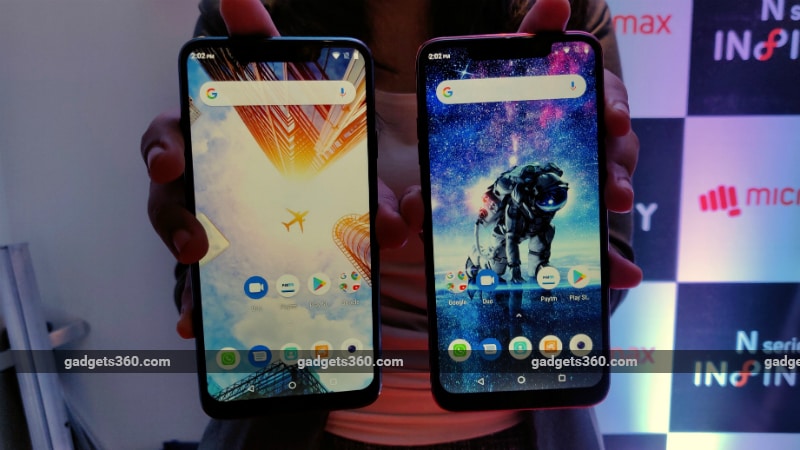Micromax has been silent for the better part of 2018 but is now set to make a comeback with its new Infinity ‘N’ series of smartphones. With the Infinity N11 and Infinity N12, Micromax has tried to catch up with all the buzzwords of 2018. Both new Micromax smartphones feature notches, minimal borders around their displays, and AI- powered enhancements. Other highlights of Infinity N11 and Infinity N12 include dual rear cameras, 4,000mAh batteries, and Android 8.1 Oreo out of the box.
Micromax’s co-founder Vikas Jain stated at the launch event that the company has made a concerted effort to price these phones affordably. The Infinity N12 has been priced at Rs. 9,999 and the Infinity N11 comes in at Rs. 8,999. Both smartphones will go on sale through major online and offline stores across India starting on December 25. We got to spend some time with them at Micromax’s launch event in New Delhi, and here are our first impressions
The Infinity N11 and Infinity N12 are made predominantly out of plastic. The phones look identical from the front and sport sizeable notches as well as prominent chins. Both have their power buttons and volume rockers on the right, and they are tactile and well located. The phones have their Micro-USB ports and headphone jacks at the bottom, and SIM trays up top, each with dedicated slots for two Nano-SIMs and a microSD card.
Thanks to their rounded corners and curved edges, both phones fit well in the palm of our hand. They are both surprisingly light too, despite the 4,000mAh batteries under their hoods. While it is too early to pass judgement on build quality, the all-plastic construction did feel slightly cut-rate compared to what we now have in the market at this price level, but we’ll reserve
The Infinity N12’s back panel has a glossy finish which is very reflective and incredibly prone to picking up fingerprints. There are three colours on offer — Blue Lagoon, Velvet Red, and Viola — all of which sport gradient finishes. The Infinity N11 in comparison has a matte back with a rubberised strip running across the left side, similar to the design of the Honor 8X (Review).
![]() The Infinity N11 (left) and Infinity N12 are made predominantly out of plastic
The Infinity N11 (left) and Infinity N12 are made predominantly out of plastic
The Micromax Infinity N11 and Infinity N12 both feature 6.19-inch HD+ (720×1500 pixels) displays with 18.9:9 aspect ratios. In our brief time with these two phones, we were pleased with the brightness and colour rendition of their screens, but slightly underwhelmed by the HD+ resolution, due to which text and images appeared slightly fuzzy at times.
Both smartphones are powered by the MediaTek Helio P22 SoC, with the Infinity N12 sporting 3GB of RAM and the Infinity N11 making do with 2GB. The Helio P22 is fabricated using a 12nm process and features NeuroPilot AI technology which can handle deep learning for facial detection as well photo and video enhancement. Micromax claims it has worked closely with MediaTek to fine-tune performance on both phones.
We will have to test these two smartphones extensively to pass a final verdict on their performance, but our initial impressions were more or less positive. We saw smooth UI animations, and apps seemed to load quickly. The Infinity N11’s 2GB of RAM might impact multi-tasking and act as a performance bottleneck in the long run, but we will have to wait till we get our hands on the device to say so for sure.
The two new smartphones both run Android 8.1 Oreo, which has been slightly customised by Micromax. The UI is much cleaner than what we’ve seen from this company before, but some bloat still remains. Micromax has boldly promised that it will roll out Android Pie updates for both smartphones within the next 45 days.
![]() The Infinity N11 (shown above) and Infinity N12 feature display notches
The Infinity N11 (shown above) and Infinity N12 feature display notches
Both smartphones have 32GB of storage, which can be expanded via a microSD card (up to 128GB). Micromax promises standby time of 450 hours, 30 hours of talktime, and 6 hours of video playback for both phones. We will have to wait and see what these claims actually translate to in the real world.
As with most smartphones these days, the Infinity N11 and Infinity N12 feature AI-enhanced rear cameras which can automatically adjust the brightness, contrast, and saturation of your shots based on the conditions they detect.
Both phones sport 13+5 megapixel dual camera setups at the rear, but the Infinity N11 has an 8-megapixel selfie camera while the Infinity N12 has a 16-megapixel selfie shooter. There are multiple modes in the camera app, such as Beauty, Bokeh, Panorama, and Time Lapse, as well as a mode called FaceCute which is basically Micromax’s own name for AR stickers.
Comebacks are tough to pull off, but Micromax’s co-founder told Gadgets 360 that the company is still in it for the long haul. With the Infinity N11 and Infinity N12, Micromax seems to have caught up with the competition on paper, but neither phone really stands out and there’s no USP for the brand. Competition is already hot in the sub-Rs. 10,000 space thanks to capable smartphones from the likes of Asus, Realme, Honor, and Xiaomi, so Micromax definitely has its work cut out for it.
Stay tuned to Gadgets 360 for our full reviews of the Micromax Infinity N11 and Infinity N12, in which we will evaluate their design, displays, software, performance, battery life, and cameras in detail.



